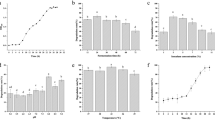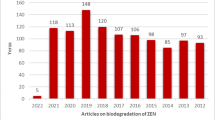Abstract
Zearalenone (ZEN) is a non-steroidal estrogen produced by many Fusarium species in cereals and other plants, and is frequently implicated in safety of foods and feeds. A ZEN-degrading microorganism has been isolated and identified as a Bacillus subtilis subspecies. It degraded 99% ZEN (1 mg kg−1) in liquid medium after 24 h and more than 95% of ZEN (0.25 mg kg−1) could be degraded after 48 h in a solid-state fermentation. This isolate can thus be used to decontaminate raw materials, like grains, to reduce the mycotoxin concentration.
Similar content being viewed by others
Explore related subjects
Discover the latest articles, news and stories from top researchers in related subjects.Avoid common mistakes on your manuscript.
Introduction
Mycotoxins produced by toxigenic strains of fungi are a widespread source of contamination in foods and feeds (Bryden 2007). Molds such as Aspergillus, Penicillium, Fusarium, and Alternaria may produce toxic compounds causing health problems (Bennett and Klich 2003; Overy et al. 2003).
Fusarium mycotoxins are secondary metabolites that occur naturally in a variety of animal feeds and foods. In particular, zearalenone [ZEN, 6-(10-hydroxy-6-oxo-trans-1-undecenyl)-B-resorcyclic acid lactone], is a non-steroidal estrogenic mycotoxin (Fig. 1), mainly produced by F. graminearium and F. culmorum found in a variety of host plants and soil (Tanaka et al. 1988).
Mycotoxin contamination occurs in the field before harvest or during storage. Mycotoxins are removed or neutralized from contaminated feed or foods by decontamination. Several physical, chemical, and biological strategies are available for decontamination and detoxification, but physical and chemical detoxification methods are costly and may destroy essential nutrients and reduce its palatability (Bhatnagar et al. 1991).
As biological detoxification, enzymatic or microbial degradation of mycotoxins has been an active subject of research (Binder et al. 2000; Altalhi 2007). Several Rhizopus strains, including R. stolonifer, R. oryzae, and R. microsporus, completely degrade ZEN (El-Nezami et al. 2002). Mokoena et al. (2005) also reported that lactic acid bacteria fermentation can significantly reduce the ZEN concentration in maize by 68–75%. However, such a reduction may not be sufficient for complete detoxification of the toxin.
Therefore, the aim of this study was to isolate a new ZEN-degrading microorganism for biological detoxification and to examine its ability to degrade ZEN in liquid medium as well as solid-state fermentation.
Materials and methods
Determination of ZEN
Analysis of ZEN was performed by ELISA and HPLC. ELISA was performed according to the manufacturer’s instructions (Romer Labs, Inc., MO) by mixing 200 μl of conjugate with 100 μl of each standard or sample and then adding 100 μl of the mixture into an antibody-coated microwell which was held at room temperature for 10 min. After incubation, the solution was discarded and the microwell was washed five times with deionized water. The substrate (100 μl) was dispensed into the microwell and incubated at room temperature for 5 min. After the addition of stopping solution (100 μl), the microplate was read using a microplate reader with a 450 nm filter.
An immunoaffinity column was used for HPLC analysis. Each sample, 100 g, was finely ground using a mill and homogenized. Samples (25 g) were extracted with 125 ml 75% (v/v) acetonitrile/water for 2 min. After blending, the samples were filtered using Whatman filter paper, and the filtrate was diluted with 80 ml phosphate buffered saline. Ten microliters filtrate was then passed through the immunoaffinity column at 5 ml min−1, followed by 20 ml distilled water at 5 ml min−1. ZEN was eluted with 1.5 ml acetonitrile and 1.5 ml distilled water and collected in a clean vial. These two eluted samples were mixed and analyzed using an HPLC system. Quantification of ZEN was determined by measuring peak areas based on a calibration curve using standard ZEN (Sigma). Three replications were performed to determine the ZEN amount.
Screening of microorganisms
To isolate ZEN-degrading microorganisms, highly ZEN-contaminated grains, wastewater and soil near farm areas, and fallen leaves were screened for the activity of ZEN degradation. For multiplication of microbes isolated in the samples, total of 40 samples were pre-cultured using nutrient broth at 33°C for 24 h. Cultured samples were spread on nutrient agar, potato/dextrose/agar, and BromoCresol Purple (BCP) agar for isolation of bacteria, molds, and lactic acid bacteria, respectively. All single isolated colonies were cultured in nutrient broth, potato/dextrose/broth, and MRS broth as appropriate. ZEN was added at 1 mg kg−1 in the culture broth and incubated with shaking for 24 h. After incubation, mycotoxin-degrading activity was tested using an ELISA kit.
ZEN degradation in liquid medium
The isolated strain was cultured in 100 ml lysogeny broth at 37°C for 24 h with a shaking (180 rpm). The cells were harvested by centrifugation at 4°C. Cell pellets were washed twice with phosphate buffer (67 mM; pH 7.0), resuspended in phosphate buffer (pH 7.0), and disintegrated using an ultrasonic homogenizer with the cells on ice. The disintegrated cells were centrifuged at 20,000×g for 20 min at 4°C. After centrifugation, the supernatant was filtered using a sterile, 0.2 mm pore, cellulose, pyrogen-free, disposable filter. ZEN degradation was performed in 2 ml Eppendorf tubes in 1 ml with initial ZEN at 1 mg kg−1.
Solid-state fermentation
Solid-state fermentation (SSF) of the isolate was evaluated for ZEN degrading ability. ZEN-contaminated grain as a solid substrate was selected for biological degradation. After six grains (soybean meal, rice bran, wheat, wheat bran, corn, and corn distiller’s dried grains with soluble—DDGS) were tested, DDGS was selected as a raw material highly contaminated with ZEN. DDGS with an initial water content of 12% (v/w) and pH of 4.1 was adjusted to a desired level of water content and pH. The solid substrate was then thoroughly mixed and introduced in a stainless steel tray, and autoclaved at 121°C for 15 min. The sterile solid medium was inoculated with B. subtilis and incubated at 37°C for 48 h. The total cell concentration of inoculum was 108 c.f.u. ml−1.
Results and discussion
Isolation of microorganisms capable of degrading ZEN
Forty colonies isolated from various samples for potential ZEN degrading microbial strains were screened (data not shown). Among them, one strain—GB—from soil, which was able to degrade ZEN most, was isolated and identified (see Supplementary Fig. 1). The isolated B. subtilis subspecies degraded more than 95% of the ZEN in 24 h in lysogeny broth. However, besides the Bacillus strain there were other isolated bacteria, like Lactobacillus, having less ZEN degradability.
Various bacteria, yeasts, and fungi can convert ZEN to α- and β-zearalenol (Altalhi 2007). However, B. subtilis has never been reported as a ZEN-degrading bacteria.
ZEN degradation by B. subtilis
The ability of B. subtilis to degrade ZEN is shown in Fig. 2. After 24 h, ZEN was not detected. α-Zearalenol, β-zearalenol, and other metabolites of ZEN were not detected after 36 h (see Supplementary Fig. 2). These results indicate that degradation of ZEN was complete.
Degradation of ZEN by B. subtilis in lysogeny broth. Control (filled square), ZEN degradation (filled triangle), B. subtilis (filled circle). Initial concentration of ZEN was 1 mg kg−1. Control was the condition where no B. subtilis cell was added, but all other conditions were identical. The initial cell concentration was 100 c.f.u. ml−1. All mixtures were incubated in the dark at 37°C for 24 h. After incubation, ZEN content was analyzed using HPLC. Determinations were average of three replications and error bar indicates standard deviation
To confirm the fraction responsible for degrading ZEN, the strain B. subtilis was cultured in lysogeny broth with 1 mg ZEN kg−1 for 48 h. After cultivation, cultures were centrifugated and cell pellets and supernatant were each tested for ZEN degradation. The cell pellets had a higher degradation activity of 55%, while the supernatant had lower degradation activity, indicating that the degrading activities of ZEN were poorly secreted into the culture medium (Fig. 3).
Microbial degradation of ZEN was also tested using ZEN-contaminated DDGS samples. Raw DDGS was contaminated with ZEN at 0.25 mg kg−1 and fermented at 37°C and pH 7.0 as an optimum condition, which was established based on the results regarding the effects of fermentation temperature and pH (data not shown). In addition, optimum condition for SSF was determined as 1% inoculum size and 40% initial moisture content of raw materials (data not shown). During the fermentation, the microbial count increased from 105 to 109 c.f.u. g−1 after 48 h of SSF (Fig. 4). The level of ZEN in the DDGS decreased from 0.25 to 0.022 mg kg−1 after 24 h of fermentation (greater than 90% decline). Furthermore, ZEN declined during fermentation as growth of B. subtilis increased. The concentration of ZEN decreased after 6 h of fermentation, and during the same period, microbial growth also increased. After 48 h fermentation, ZEN was less than 0.01 mg kg−1, indicating that ZEN level decreased during fermentation.
Degradation of ZEN in DDGS using solid-state fermentation. Control (filled square), ZEN degradation (filled triangle), Microbial growth (filled circle). Corn distiller’s dried grains with solubles (DDGS) was used as a raw material contaminated with ZEN at 0.25 mg kg−1. ZEN degrading activity during fermentation was measured using HPLC. As a control, a condition where no B. subtilis cell was added, but all other conditions were identical. Three replications were performed to determine the ZEN degrading activity of the isolate on DDGS. Determinations were average of three replications and error bar indicates standard deviation
In summary, B. subtilis degraded about 99% of ZEN in liquid and SSF tests. Thus, the SSF method described here could be directly used in ZEN-contaminated raw materials like grains to reduce the mycotoxin level at a low cost. No other Bacillus strain has been reported capable of degrading ZEN before.
References
Altalhi AD (2007) Plasmid-mediated detoxification of mycotoxin zearalenone in Pseudomonas sp. ZEA-1. Am J Biotechnol Biochem 3:150–158
Bennett JW, Klich M (2003) Mycotoxins. Clin Microbiol Rev 16:497–516
Bhatnagar D, Lillehoj EB, Bennett JW (1991) Biological detoxification of mycotoxins. In: Smith JE, Henderson RS (eds) Mycotoxins and animal foods. CRC Press, Boston, pp 816–826
Binder EM, Heidler D, Schatzmayr G, Thimm N, Fuchs E, Schuh M, Krska R, Binder J (2000) Microbial detoxification of mycotoxins in animal feed. In: Proceedings of the 10th international IUPAC symposium on mycotoxins and phycotoxins, Brazil
Bryden WL (2007) Mycotoxins in the food chain: human health implications. Asia Pac J Clin Nutr 16:95–101
El-Nezami H, Polychronaki N, Salminen S, Mykkanen H (2002) Binding rather than metabolism may explain the interaction of two food-grade lactobacillus strains with zearalenone and its derivative α-zearalenol. Appl Environ Microbiol 68:3545–3549
Mokoena MP, Chelule PK, Gqaleni N (2005) Reduction of fumonisin B1 and zearalenone by lactic acid bacteria in fermented maize meal. J Food Prot 68:2095–2099
Overy DP, Seifert KA, Savard ME, Frisvad JC (2003) Spoilage fungi and their mycotoxins in commercially marketed chestnuts. Int J Food Microbiol 2737:1–9
Takahashi-Ando NEA (2004) Metabolism of zearalenone by generally modified organisms expressing the detoxification gene from Clonostachys rosea. Appl Environ Microbiol 70:3239–3245
Tanaka T, Hasegawa A, Yamamoto S, Lee US, Sugiura Y, Ueno Y (1988) Worldwide contamination of cereals by the Fusarium mycotoxins, nivalenol, deoxynivalenol, and zearalenone. I. Survey of 19 countries. J Agric Food Chem 36:979–983
Acknowledgments
This study was supported by the Technology Development Program for Agriculture and Forestry, Ministry for Food, Agriculture, Forestry and Fisheries, Republic of Korea.
Author information
Authors and Affiliations
Corresponding author
Additional information
Purpose of work: The aim of this work was to decontaminate raw materials like grains containing zearalenone using a Bacillus subtilis strain isolated from soil.
Electronic supplementary material
Below is the link to the electronic supplementary material.
Rights and permissions
About this article
Cite this article
Cho, K.J., Kang, J.S., Cho, W.T. et al. In vitro degradation of zearalenone by Bacillus subtilis . Biotechnol Lett 32, 1921–1924 (2010). https://doi.org/10.1007/s10529-010-0373-y
Received:
Accepted:
Published:
Issue Date:
DOI: https://doi.org/10.1007/s10529-010-0373-y








